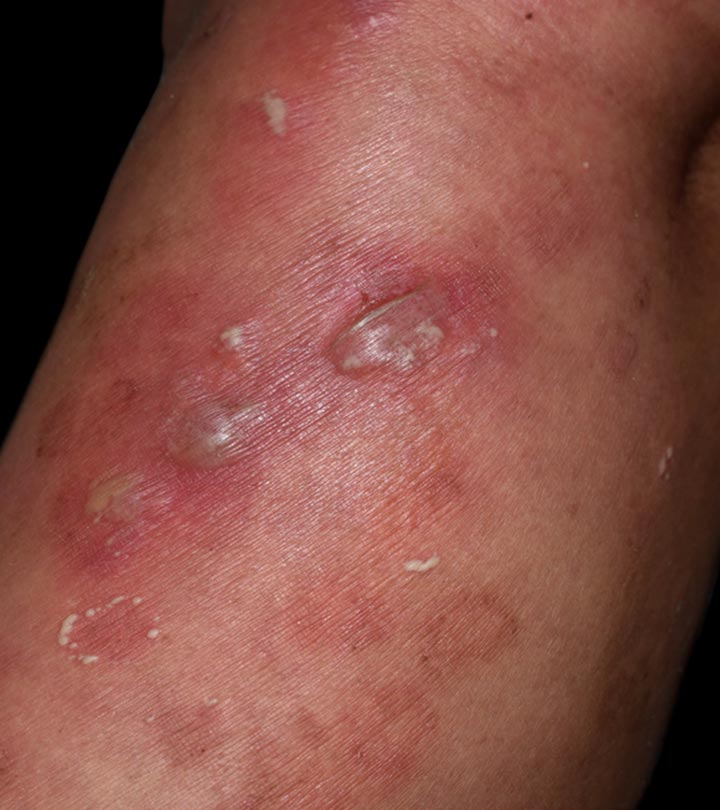Vesicular skin lesions are tiny, liquid-filled, blister-like bumps on your skin. The fluid inside that sac can be clear or mixed with pus or blood. Multiple reasons may cause blisters on your skin. This may include friction or infection. However, in some cases, vesicular lesions may indicate serious underlying conditions. Read this article to understand the causes of vesicular skin lesions and learn about the diagnosis, treatment, and prevention tips.
In This Article
What Is Vesicular Skin?
Vesicular skin lesions are nothing but blisters. They are small sacs filled with either clear or pus-colored fluid. They are typically 5-10mm in diameter. They are delicate and can burst due to pressure or friction. When a vesicle bursts, it becomes a vesicular eruption. Once they burst, the liquid spreads to the surrounding skin and leaves a white or yellow flaky crust when it dries. If the diameter of the lesion is more than ½ cm, it is called bullae.
In the next section, let us understand some of its symptoms.
Related: 10 Effective Home Remedies To Get Rid Of Blood Blisters
Symptoms Of Vesicular Skin
Vesicular skin lesions can be easily identified. They develop on the surface of your skin and appear to be swollen and filled with liquid. They can cause redness, itching and can be painful to touch. Over time, they generally disappear by themselves.
While the symptoms of vesicular skin lesions may be easy to detect, the causes are numerous. In the upcoming section, let us look at some of the causes of vesicular skin lesions.
What Are The Causes For Vesicular Skin?
Shutterstock
Vesicular skin lesions or blisters can be caused by something as benign as lifting heavy weights at the gym without gloves, breaking into a new pair of shoes, or suffering a burn on your skin. Some of the more serious causes are as follows.
- Frostbite
Shutterstock
If you’ve got frostbite, bullae (vesicular skin lesions) will begin to appear when the affected area is re-warmed (1).
- Allergic Contact Dermatitis
It is common for vesicular skin lesions to appear in acute cases of allergic contact dermatitis. This is an inflammatory skin disease that is caused by the aggravation of contact dermatitis due to allergen or irritants (2).
Related: 14 Best Home Remedies For Skin Allergies | Causes And Symptoms
- Covid -19
Recent studies have suggested that vesicular skin lesions may be one of the side effects of Covid-19 (3). A study analyzed 24 patients who showed symptoms of Covid -19. Out of the 24, 19 of them developed vesicular skin lesions after the onset of Covid-19’s symptoms.
- Bacterial And Fungal Infections
Bacterial and fungal infections can also cause vesicular skin lesions to manifest. Cuts and wounds on your skin not cared for may cause you to come in contact with these bacteria and fungi. Erysipelas, Herpes zoster, and Herpes simplex are some of the most common infections to cause vesicular skin lesions (4).
It is important to seek medical assistance in the above cases of vesicular skin lesions. Let us understand what other situations will require medical assistance.
Related: 11 Best Home Remedies For Yeast Infection That Actually Work
When To See A Doctor?
Shutterstock
It is possible to treat most vesicular skin lesions and blisters with the help of OTC medications. If you start to feel pain, dizziness or are having an allergic reaction to OTC medications, seek medical assistance immediately.
In the next section let us understand how vesicular skin lesions are diagnosed.
How To Diagnose Vesicular Skin Lesions?
If you notice strange vesicles that appear on your skin, you should consult with your doctor. You will be asked questions about your recent medical history or any medications that you may be taking. This is to help determine if any pre-existing medical condition is related to your vesicular skin lesions.
The doctor will also examine your skin to diagnose the cause. If your doctor is unsure of the diagnosis, they may ask you to undergo a few tests. The doctor may collect a sample of the fluid and perform a biopsy of the skin tissue of the vesicle. This is sent to a laboratory for analysis that will help arrive at a final diagnosis.
Once your diagnosis is complete, you will know if the vesicular skin lesion is benign or is it an underlying medical condition that is causing these lesions.
StyleCraze SaysBesides a biopsy, other tests for vesicle diagnosis include blood samples and STD testing.
In the next section let’s find out how vesicular skin lesions are treated.
Treatment Options Available For Vesicular Skin
Shutterstock
Treatment for vesicular skin lesions varies from case to case. It is strongly recommended that you do not pick or scratch open the vesicle. If it becomes too painful and swollen, you can go to a doctor, and they will safely drain the fluid. This allows the skin to heal effectively and avoid the risk of developing an infection.
In most cases, over-the-counter medications(OTC) are prescribed by your doctor as part of your treatment. For cases where vesicular skin lesions are caused due to allergic reactions, or poison ivy, antihistamines ointments are prescribed.
In the case of vesicular skin lesions caused by Covid-19, antihistamines, anticoagulants, and corticosteroids are prescribed as part of the treatment (5). Lesions caused by burns will be treated with burns creams and oral antibiotics.
Avoid self-medication and consult a doctor in these cases.
SubscribeStylecraze TriviaTreatment to soothe vesicular itching includes colloidal oatmeal baths, cold compress, and calamine lotions.
Is there a way to prevent vesicular skin lesions? Let us find out in the next section.
How To Prevent Vesicular Skin?
Shutterstock
Vesicular skin lesions are not always preventable. Especially genetic lesions like Epidermolysis bullosa simplex. This is a genetic condition that causes your skin to be fragile and makes it prone to blistering (6). Allergic vesicular lesions also can’t be prevented. You have to take necessary precautions to avoid allergens that trigger this condition. You should also maintain good skin hygiene and use antibacterial soaps to wash your skin to protect it from infections.
Vesicular skin lesions are small bumps filled with blood or pus accompanied by redness, itchiness, and pain. Factors such as genetics, infections, frostbite, or heavy lifting may lead to the development of painful vesicular skin lesions. If your vascular skin lesions are painful and swollen, consult your doctor. They may prescribe OTC creams, ointments, or medications to treat the condition. While vesicular skin lesions cannot be completely avoided, taking preventive measures such as maintaining excellent personal hygiene can reduce your chances of developing vesicular skin lesions.




